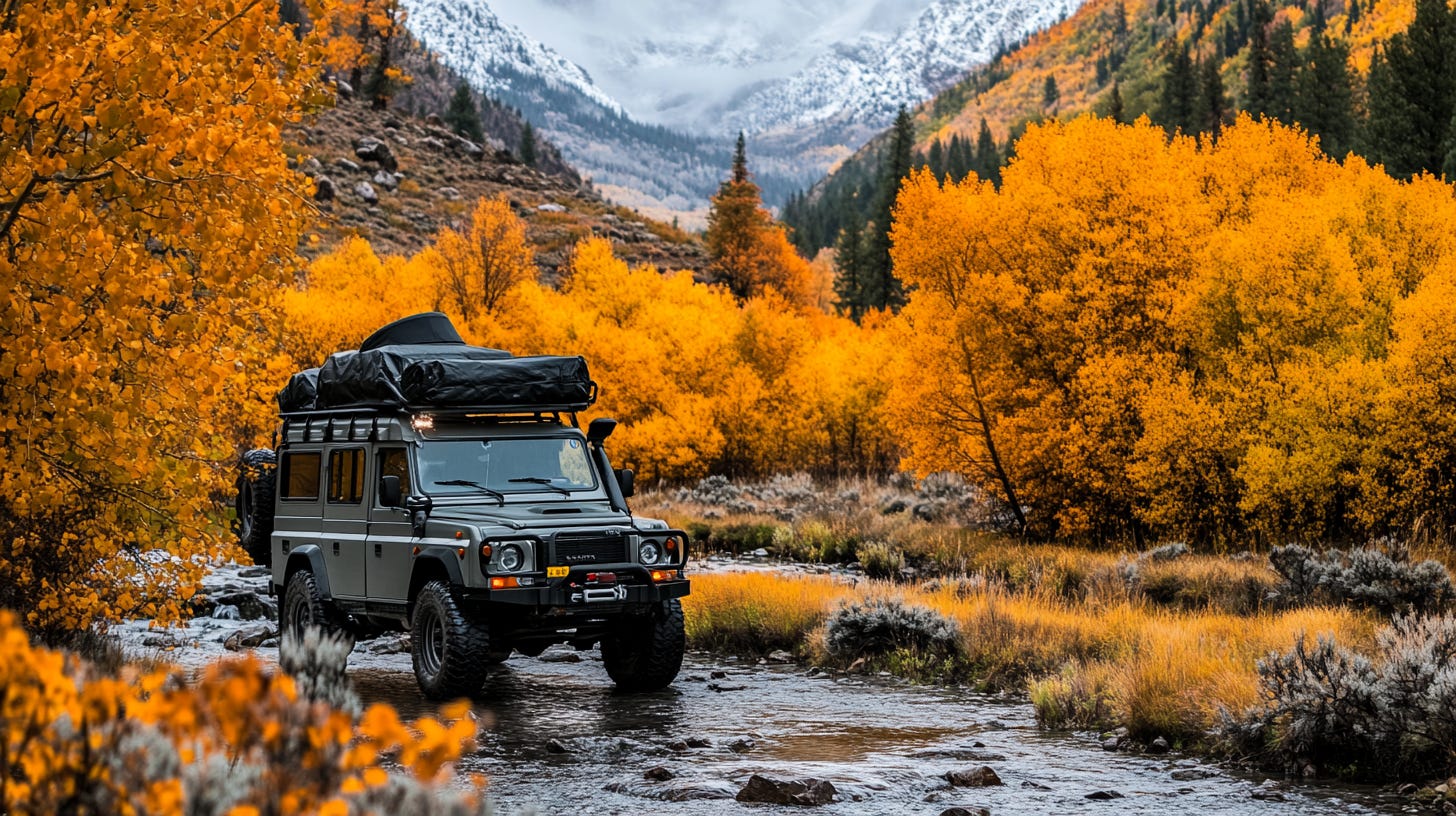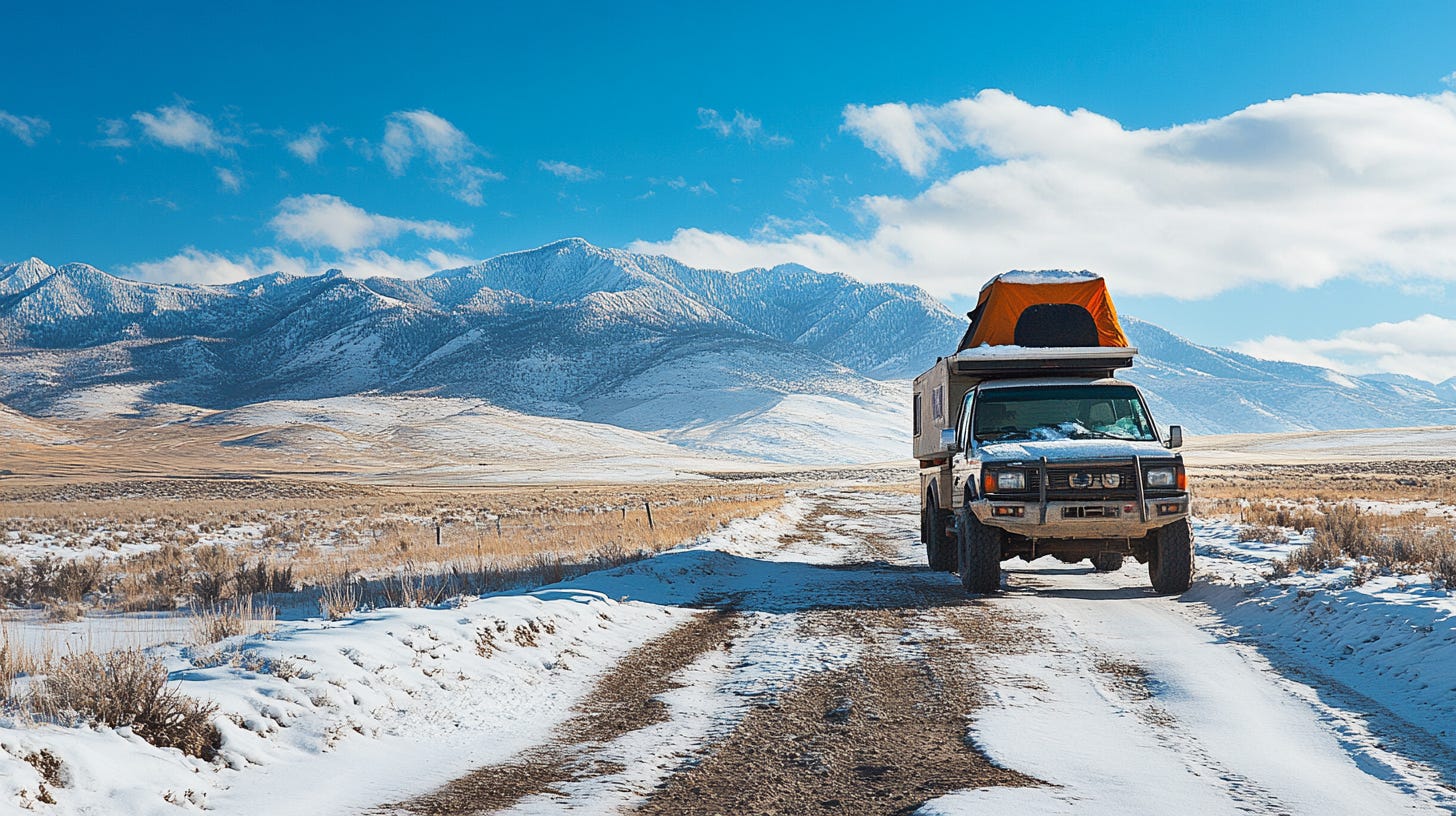Overlanding Through the Seasons: Tips for Year-Round Adventure

Overlanding is an incredible way to explore the world, but no two trips are ever quite the same—especially when you’re navigating through the different seasons. Whether it’s the crisp air of winter or the blazing heat of summer, every season presents its own set of unique challenges and rewards. To make the most of your adventures year-round, you’ll need to adapt your gear and strategies to meet the demands of each season. Here’s a guide to help you tackle overlanding throughout the year, from snowy winter excursions to summer desert treks

Winter: Embrace the Chill ❄️
Winter overlanding is not for the faint of heart, but it rewards you with a serene landscape that few get to see. The quiet beauty of snow-covered forests and remote frozen lakes can make winter one of the most memorable seasons for overlanding.
Tips for Winter Overlanding
- Gear Up for the Cold: Invest in high-quality cold-weather gear, including an insulated sleeping bag (rated for at least -20°F) and a reliable four-season tent. Cold weather can be unforgiving, so staying warm is crucial.
- Keep the Vehicle Ready: Snowy trails and icy roads demand specific equipment. All-terrain tires may not cut it in deep snow—you’ll want winter-specific tires with deep treads and softer rubber. Carry traction boards, a shovel, and tire chains in case you need extra grip.
- Layer Up: Dress in layers so you can adjust your clothing to match your activity level and prevent sweating, which can lead to chilling. Thermal base layers, fleece mid-layers, and a waterproof outer shell are all essential.
- Watch for Ice: Snow might seem fluffy and harmless, but ice is often lurking beneath. Be mindful of frozen surfaces, and always test questionable patches before driving over them—better safe than stranded.
Winter Highlights
- Quiet Trails: With fewer people on the roads, you’ll often have entire trails and campsites to yourself.
- Starry Nights: Cold winter nights offer some of the clearest skies, making stargazing an unforgettable experience

Spring: Rebirth and Adventure 🌱
Spring is a time of renewal, and it brings some unique challenges and rewards. Melting snow can create challenging muddy terrain, but the budding trees and blooming wildflowers make it all worthwhile.
Tips for Spring Overlanding
- Prepare for Mud: Melting snow means muddy trails, so it’s essential to have mud-terrain tires or at least all-terrain tires capable of handling slippery conditions. Keep traction boards and a winch on hand to help pull yourself out if you get stuck.
- Waterproof Gear: Spring means rain, so it’s important to waterproof your gear. Pack a rainfly for your tent, use dry bags for your clothing and equipment, and keep a set of waterproof clothing easily accessible.
- Watch the Weather: Spring weather can be unpredictable, with warm sunshine one day and heavy rains the next. Keep a close eye on the forecast and always have a plan B in case conditions change rapidly.
Spring Highlights
- Wildflowers: Trails and campsites are often lined with blooming wildflowers, making for some of the most beautiful scenery of the year.
- Water Crossings: Rivers and streams swell in the spring, providing fun and challenging water crossings. Just be cautious, as fast-flowing water can be dangerous.
Summer: The Call of the Desert ☀️
Summer is the prime season for overlanding, especially in mountainous regions or desert landscapes. With the dry weather and long days, you can cover more ground and experience the beauty of the great outdoors in full force.
Tips for Summer Overlanding
- Stay Cool: Overlanding in summer means dealing with heat. Pack plenty of water (at least a gallon per person per day), and ensure your vehicle’s cooling system is in good shape. Install a 12V fan in your tent to keep air circulating during hot nights.
- Sun Protection: Protect yourself from the sun by wearing a wide-brimmed hat, sunglasses, and lightweight, long-sleeved clothing. It may sound counterintuitive, but covering up with breathable fabrics helps prevent sunburn and keeps you cooler.
- Plan Around the Heat: Travel early in the morning or late in the afternoon to avoid the peak heat of the day. Set up camp during midday and find a shady spot to rest and relax.
- Watch Tire Pressure: Hot temperatures can cause your tire pressure to rise. Be sure to check tire pressure often and adjust accordingly to avoid blowouts.
Summer Highlights
- Desert Treks: The dry season is perfect for exploring desert landscapes, like Death Valley or the Mojave Road, where cooler times of the year might bring flash floods.
- Long Days: Extended daylight hours mean more time for exploration and adventure.
Fall: Crisp Air and Stunning Views 🍂
Fall is a favorite season for many overlanders. The summer crowds have disappeared, the air is crisp, and the vibrant colors of changing leaves make for some spectacular scenery.
Tips for Fall Overlanding
- Prepare for Temperature Swings: Fall temperatures can vary dramatically between day and night. Pack layers to stay warm during cool mornings and evenings while remaining comfortable during sunny afternoons.
- Check for Closures: Many campgrounds and trails begin to close during the fall, so be sure to check ahead of time to make sure your destination is still accessible.
- Avoid Overpacking: With cool weather, you might be tempted to pack more clothing and gear, but staying organized is key. Stick to layers that work well together, and make sure you have reliable storage solutions.
Fall Highlights
- Changing Leaves: The vibrant reds, oranges, and yellows of the fall foliage create breathtaking landscapes that are worth the journey alone.
- Perfect Campfires: The crisp, cool evenings make for the perfect campfire atmosphere—ideal for storytelling, marshmallow roasting, and keeping warm.
Year-Round Tips for Overlanding Success
- Be Prepared for Emergencies: Regardless of the season, always carry a first aid kit, plenty of food, and a reliable communication device, such as a satellite phone or PLB, in case you lose cell service.
- Routine Vehicle Maintenance: Seasonal weather changes can affect your rig in different ways. Before heading out, always perform a thorough check of your vehicle, from the tires to the fluids, ensuring it’s ready for the conditions ahead.
- Adapt Your Gear: Gear that works great in one season might not be effective in another. Always assess your gear before setting out—swap out sleeping bags, adjust clothing, and make sure your vehicle is equipped for the conditions you’ll face.
Final Thoughts
Overlanding is a year-round adventure, and every season brings its own challenges and beauty. Embrace the quiet of winter, the renewal of spring, the heat of summer, and the colors of fall—you’ll find that each journey brings new experiences and memories to cherish. With the right preparation and gear, you’ll be ready to take on whatever Mother Nature has in store, one trail at a time.
No matter the season, get out there, explore, and enjoy the ride! Happy trails, everyone! 🚙💨






Member discussion